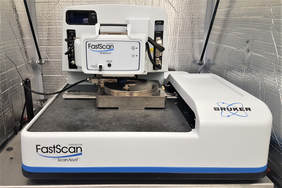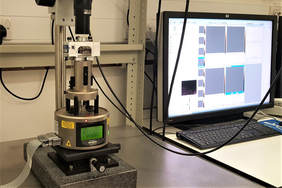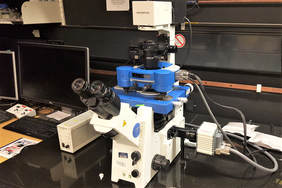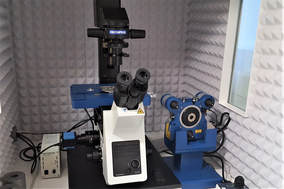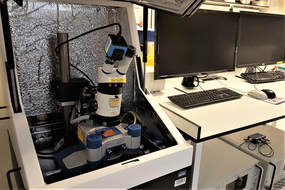Atomic Force Microscopy (AFM)
Atomic force microscopy (AFM) uses a sharp tip to scan the contours of a surface, “touching” and “feeling” single molecules and/or atoms, just like a blind person's fingertip reading Braille. Since AFM can be carried out in liquid, we can probe and image biomolecules under conditions that are very near to those in a living cell. This enables us, for example, to probe the helicity of DNA molecules and to visualise membrane pore formation as it happens. With new generations of microscopes that can capture images at a time-scale of seconds or below, we work to increase our understanding of biomolecular dynamics and interactions.
Facilities
At the London Centre for Nanotechnology, we make use of an extensive suite of atomic force microscopy systems for nano-scale surface characterisation and functional imaging under ambient conditions. The following instruments are included in a facility that serves a wide academic community across University College, Imperial College and King's College London and Birkbeck, University of London, as well as commercial users (for booking by registered users, see here). For more information on AFM training and access to our facilities, please contact Richard Thorogate.
|
Bruker Dimension Icon
The Bruker Dimension Icon is convenient for low noise, large sample analysis, which provides a 90 micron scan range system with a low noise closed loop XYZ scanner. The Icon supports PeakForce QNM Imaging to allow researchers to image sample topography and map nanomechanical properties simultaneously (1 MPa - 50 GPa modulus). It also features a number of electrical characterisation modes with increased sensitivity and dynamic range. |
|
Bruker Dimension FastScan
The Bruker Dimension FastScan AFM allows imaging rates up to frames/second without sacrificing resolution from subnanometer to 100s of nanometers in height. The FastScan scanner provides vertical noise below 40 pm with high accuracy with ultra-low drift and will provide excellent quality images and maintaining high spatial resolution at >100 Hz scan line rates. |
|
Bruker Multimode 8 (x3)
The LCN has three Bruker MultiMode 8 AFM's which are equipped with an E scanner or J scanner with heater and uses the unique PeakForce Tapping™ technology to provide new information, faster results and greatly improved ease of use. ScanAsyst allows direct control of the tip-sample interaction force and optimisation of imaging parameters. PeakForce QNM, analyses each tip-sample interaction to extract nanomechanical properties including modulus, adhesion, deformation, and dissipation. |
|
Bruker (formerly JPK) Nanowizard 4
The Nanowizard 4 combines fast scanning with high resolution at scan sizes up to 100um and is designed to provide mechanical and thermal stability on inverted optical microscopes for long term imaging. This allows time lapse imaging of living cells or single molecules and observation of cell or tissue dynamics in real time. It comes equipped with QI mode for quantitative material property mapping and a top down camera option. |
|
Bruker (formerly JPK) Ultra Speed (x2)
The LCN is equipped with two Bruker Nanowizard ULTRA Speed AFMs for fast scanning at up to 300 Hz line rate in air and liquid at high resolution. It comes equipped with QI mode for quantitative material property mapping and the ability to correlate optical microscopy and AFM images with DirectOverlayTM. One system is equipped with a motorised stage and petri dish heater |
|
Bruker (formerly JPK) CellHesion 200 (x2)
The LCN currently has two Bruker CellHesion 200 systems primarily for measuring cell to cell or cell to substrate interactions. It can also quantify cell elasticity and response to mechanical stress. One system is normally permanently mounted on an Olympus FV1000 confocal system and the other can be moved between inverted and upright set ups. |
|
Bruker (formerly JPK) Nanowizard 1
The LCN currently has one Bruker Nanowizard 1 AFM system mainly to provide high resolution imaging and mechanical information of biological samples using a closed feedback loop to ensure precise positioning of the X, Y and Z dimensions. The AFM head is used with upright optics and is situated inside of an acoustic isolation hood. |

